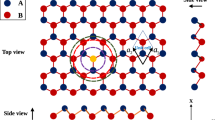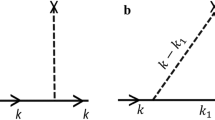Abstract
We study exchange interaction between two magnetic impurities, i.e. the Ruderman–Kittel–Kasuya–Yosida (RKKY), in doped germanene layer by directly computing Green’s function within the full band method. Kane–Mele model Hamiltonian in the presence of spin–orbit coupling and longitudinal magnetic field has been applied to describe electron dynamics. The behaviour of RKKY interaction as a function of distance between the localised moments has been analysed for different values of magnetic field and spin–orbit coupling strength for electrons. Also, the effects of electron doping as the variation of chemical potential on behaviours of RKKY interaction have been investigated. It has been shown that a magnetic field along the z-axis mediates an anisotropic interaction which corresponds to an XXZ model interaction between two magnetic moments. The exchange interaction along the arbitrary direction between two magnetic moments has been obtained using the static spin susceptibilities of doped germanene layer in the presence of spin–orbit coupling. The effects of magnetic field, electron doping and spin–orbit coupling on the dependence of exchange interaction on distance between moments are investigated by calculating the correlation function of the spin density operators. Our results show that the electron doping impacts the spatial behaviour of RKKY interaction. Moreover, spin–orbit coupling effects on both longitudinal and transverse RKKY interactions have been investigated for doped germanene monolayer. Finally, we have studied in detail the temperature dependence of RKKY interactions for various amounts of spin–orbit coupling strengths.














Similar content being viewed by others
References
K S Novoselov, A K Geim, S V Morosov, D Jiang, Y Zhang, S V Dubonos, I V Grigorieva and A A Firsov, Science 306, 666 (2004)
K S Novoselov, A K Geim, S V Morosov, D Jiang, M I Katsnelson, I V Grigorieva, S V Dubonos and A A Firsov, Nature 438, 197 (2005)
A H C Neto, F Guinea, N M R Peres, K S Novoselov and A K Geim, Rev. Mod. Phys. 81, 109 (2009)
Y Zhang, T-W Tan, H L Stormer and P Kim, Nature 438, 201 (2005)
X-L Wang, S X Dou and C Zhang, NPG Asia Mater. 2, 31 (2010)
R Chegel and S Behzad, Sci. Rep. 10, 704 (2020)
S Cahangirov, M Topsakal, E Akturk, H Sahin and S Ciraci, Phys. Rev. Lett. 102, 236804 (2009)
C C Liu, W Feng and Y Yao, Phys. Rev. Lett. 107, 076802 (2011)
J E Padilha and R B Pontes, The J. Chem. C 119, 3818 (2015)
S Chowdhury and D Jana, Rep. Prog. Phys. 79, 126501 (2016)
T P Kaloni, The J. Phys. Chem. C 118, 25200 (2014)
C-C Liu, H Jiang and Y Yao, Phys. Rev. B 84, 195430 (2011)
X-S Ye et al, RSC Adv. 4, 21216 (2016)
Z Qiao et al, Phys. Rev. B 82, 161414 (R) (2010)
W-K Tse et al, Phys. Rev. B 83, 155447 (2011)
C L Kane and E J Mele, Phys. Rev. Lett. 95, 146802 (2005)
F D M Haldane, Phys. Rev. Lett. 61, 2015 (1988)
E H Hwang and S Das Sarma, Phys. Rev. B 80, 075417 (2009)
R G Mani, J H Smet, K von Klitzing, V Narayanamurti, W B Johnson and V Umansky, Nature (London) 420, 646 (2002)
M A Ruderman and C Kittel, Phys. Rev. 96, 99 (1954)
T Kasuya, Prog. Theor. Phys. 16, 45 (1956)
K Yosida, Phys. Rev. 106, 893 (1957)
B Fischer and M W Klein, Phys. Rev. B 11, 2025 (1975)
V I Litvinov and V K Dugaev, Phys. Rev. B 58, 3584 (1998)
L Wojtczak, Acta Phys. Polon. A 36, 585 (1969)
S Mi, S-H Yuan and P Lyu, J. Appl. Phys. 109, 083931 (2011)
S Saremi, Phys. Rev. B 76, 184430 (2007)
L Brey, H A Fertig and S Das Sarma, Phys. Rev. Lett. 99, 116802 (2007)
A M Black-Schaffer, Phys. Rev. B 81, 2056416 (2010)
S R Power, F S M Guimaraes, A T Costa, R B Muniz and M S Ferreira, Phys. Rev. B 85, 195411 (2012)
E Kogan, Phys. Rev. B 84, 115119 (2011)
M Sherafati and S Satpathy, Phys. Rev. B 83, 165425 (2011)
G Zarand and B Janko, Phys. Rev. Lett. 89, 047201 (2002)
G D Mahan, Many particle physics (Plenum Press, New York, 1993), Vol. 2, Ch. 4, Sec. 5, p. 135
F Azizi and H Rezania, Physica E 128, 114612 (2021)
Y Soori and H Rezania, Physica E 127, 114458 (2021)
F Azizi and H Rezania, Synth. Metals 59, 38 (2021)
H Imamura, P Bruno and Y Utsumi, Phys. Rev. B 69, 121303(R) (2004)
X Li, S Wu, S Zhou and Z Zhu, Nanoscale Res. Lett. 9, 110 (2014)
A V Sologubenko et al, Phys. Rev. Lett. 98, 107201 (2007)
Y Yan, C-Q Wu and B Li, Phys. Rev. B 79, 014207 (2009)
Author information
Authors and Affiliations
Corresponding author
Rights and permissions
Springer Nature or its licensor (e.g. a society or other partner) holds exclusive rights to this article under a publishing agreement with the author(s) or other rightsholder(s); author self-archiving of the accepted manuscript version of this article is solely governed by the terms of such publishing agreement and applicable law.
About this article
Cite this article
Azizi, F., Rezania, H. Anisotropic RKKY interaction in doped monolayer germanene: spin–orbit coupling effects. Pramana - J Phys 98, 72 (2024). https://doi.org/10.1007/s12043-024-02763-w
Received:
Revised:
Accepted:
Published:
DOI: https://doi.org/10.1007/s12043-024-02763-w




